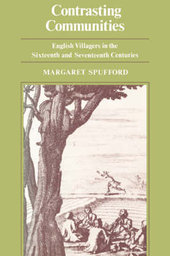
|
Contrasting Communities: English Villages in the Sixteenth and Seventeenth Centuries
Paperback / softback
Main Details
| Title |
Contrasting Communities: English Villages in the Sixteenth and Seventeenth Centuries
|
| Authors and Contributors |
By (author) Margaret Spufford
|
| Physical Properties |
| Format:Paperback / softback | | Pages:404 | | Dimensions(mm): Height 228,Width 152 |
|
| Category/Genre | British and Irish History |
|---|
| ISBN/Barcode |
9780521297486
|
| Classifications | Dewey:942.656 |
|---|
| Audience | | Tertiary Education (US: College) | |
|---|
| Illustrations |
Worked examples or Exercises
|
|
Publishing Details |
| Publisher |
Cambridge University Press
|
| Imprint |
Cambridge University Press
|
| Publication Date |
6 December 1979 |
| Publication Country |
United Kingdom
|
Description
This is a paperback edition of Margaret Spufford's history of three contrasting communities in eastern England from 1525 to 1700. It is the first book in English to attempt to portray the educational opportunities and religious convictions of the villagers of this period, as well as their economic situation. Dr Spufford has examined every class of record which bears upon these themes. She makes contact with village people of the past as full human beings and uses them as witnesses on the larger canvases of economic, social and educational history, to discuss problems of the widest historical significance.
Reviews'This is a seminal book.' Christopher Hill, Literature and Society 'A book which often comes close to attaining the ideal of an historical controlled experiment, in which the theories of the textbooks are carefully tested against historical experience. The first section ... should become required reading for all social and economic historians of the sixteenth and seventeenth centuries ... I suspect that everyone who reads this book will learn something valuable from it, whatever his particular interests.' Roger Schofield 'The demographic sections of this book are instructive, the economic and social interesting and informative, and the educational ones revelatory, but most readers will probably be drawn more to the ecclesiastical and religious ones.' Eric Kerridge, Journal of Ecclesiastical History
|